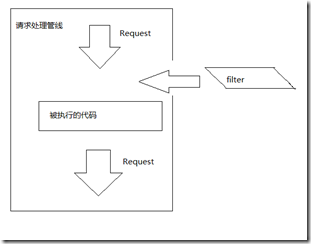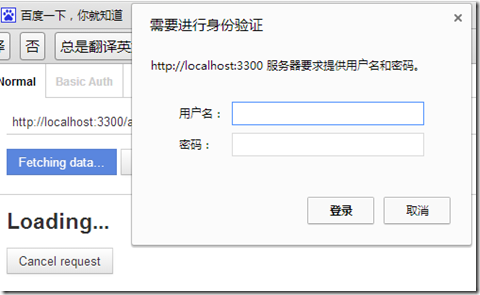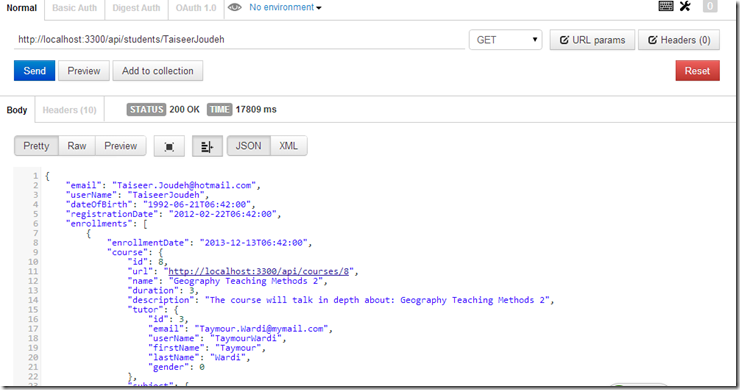使用ASP.NET Web Api构建基于REST风格的服务实战系列教程【八】——Web Api的安全性
系列导航地址http://www.cnblogs.com/fzrain/p/3490137.html
前言
这一篇文章我们主要来探讨一下Web Api的安全性,到目前为止所有的请求都是走的Http协议(http://),因此客户端与服务器之间的通信是没有加密的。在本篇中,我们将在“StudentController”中添加身份验证功能——通过验证用户名与密码来判断是否是合法用户。众所周知,对于机密信息的传递,我们应该使用安全的Http协议(https://)来传输
在Web Api中强制使用Https
我们可以在IIS级别配置整个Web Api来强制使用Https,但是在某些情况下你可能只需要对某一个action强制使用Https,而其他的方法仍使用http。
为了实现这一点,我们将使用Web Api中的filters——filter(过滤器)的主要作用就是可以在我们执行方法之前执行一段代码。没接触过得可以通过下图简单理解下,大神跳过:
我们新创建的filter将用来检测是否是安全的,如果不是安全的,filter将终止请求并返回相应:请求必须是https。
具体做法:创建一个filter继承自AuthorizationFilterAttribute,重写OnAuthorization来实现我们的需求。
在网站根目录下创建“Filters”文件夹,新建一个类“ForceHttpsAttribute”继承自“System.Web.Http.Filters.AuthorizationFilterAttribute”,下面上代码:
public class ForceHttpsAttribute : AuthorizationFilterAttribute { public override void OnAuthorization(System.Web.Http.Controllers.HttpActionContext actionContext) { var request = actionContext.Request; if (request.RequestUri.Scheme != Uri.UriSchemeHttps) { var html = "<p>Https is required</p>"; if (request.Method.Method == "GET") { actionContext.Response = request.CreateResponse(HttpStatusCode.Found); actionContext.Response.Content = new StringContent(html, Encoding.UTF8, "text/html"); UriBuilder httpsNewUri = new UriBuilder(request.RequestUri); httpsNewUri.Scheme = Uri.UriSchemeHttps; httpsNewUri.Port = 443; actionContext.Response.Headers.Location = httpsNewUri.Uri; } else { actionContext.Response = request.CreateResponse(HttpStatusCode.NotFound); actionContext.Response.Content = new StringContent(html, Encoding.UTF8, "text/html"); } } } }
在上面代码中,我们通过actionContext参数拿到request和response对象,我们判断客户端的请求:如果不是https,那么直接响应客户端应该使用https。
在这里,我们需要区分请求是Get还是其他(Post,Delete,Put),因为对于使用了Http的Get请求来访问资源,我们将使用https创建一个连接并添加在响应Header的Location中。这样做了之后客户端就会自动使用https来发送Get请求了。
对于非Get请求,直接返回404,并通知客户端必须使用https来请求
如果我们打算在整个项目中使用,那么在“WebAPIConfig”类中做如下设置:
public static void Register(HttpConfiguration config) { config.Filters.Add(new ForceHttpsAttribute()); }
如果我们相对具体的Controller或Action设置时,可以做如下设置:
//对于整个Controller强制使用Https
[Learning.Web.Filters.ForceHttps()] public class CoursesController : BaseApiController { //仅对这个方法强制使用Https
[Learning.Web.Filters.ForceHttps()] public HttpResponseMessage Post([FromBody] CourseModel courseModel) { } }
使用Basic Authentication验证用户
到目前为止,我们提供的所有Api都是公开的,任何人都能访问。但在真是场景中却是不可取的,对于某些数据,只有通过认证的用户才能访问,我们这里有两个地方恰好说明这一点:
1.当客户端发送Get请求道“http://{your_port}/api/students/{userName}“的时候.例如:通过上述URI访问userNme为“TaiseerJoudeh”的信息时,我们必须让客户端提供TaiseerJoudeh相应的用户名和密码,对于没有提供验证信息的用户我们就不让访问,因为学生信息包含一些重要的私人信息(email,birthday等)。
2.当客户端发送Post请求到“http://{your_port}/api/courses/2/students/{userName}“的时候,这意味着给学生选课,我们可以想一下,这里如果不做验证,那么所有人都能随便给某个学生选课,那么不就乱了么。
对于上面的场景,我们使用Basic Authentication来进行身份验证,主要思路是使用filter从请求header部分获取身份信息,校验验证类型是否为“basic”,然后校验内容,正确就放行,否则返回401 (Unauthorized)状态码。
在上代码前,解释一下下basic authentication:
什么是basic authentication?
它意味着在正式处理Http请求之前对请求者身份的校验,这可以防止服务器受到DoS攻击(Denial of service attacks)。原理是:客户端在发送Http请求的时候在Header部分提供一个基于Base64编码的用户名和密码,形式为“username:password”,消息接收者(服务器)进行验证,通过后继续处理请求。
由于用户名和密码仅适用base64编码,因此为了保证安全性,basic authentication通常是基于SSL连接(https)
为了在我们的api中使用,创建一个类“LearningAuthorizeAttribute”继承自System.Web.Http.Filters.AuthorizationFilterAttribute
public class LearningAuthorizeAttribute : AuthorizationFilterAttribute { [Inject] public LearningRepository TheRepository { get; set; } public override void OnAuthorization(System.Web.Http.Controllers.HttpActionContext actionContext) { //forms authentication Case that user is authenticated using forms authentication
//so no need to check header for basic authentication. if (Thread.CurrentPrincipal.Identity.IsAuthenticated) { return; } var authHeader = actionContext.Request.Headers.Authorization; if (authHeader != null) { if (authHeader.Scheme.Equals("basic", StringComparison.OrdinalIgnoreCase) && !String.IsNullOrWhiteSpace(authHeader.Parameter)) { var credArray = GetCredentials(authHeader); var userName = credArray[0]; var password = credArray[1]; if (IsResourceOwner(userName, actionContext)) { //You can use Websecurity or asp.net memebrship provider to login, for //for he sake of keeping example simple, we used out own login functionality if (TheRepository.LoginStudent(userName, password)) { var currentPrincipal = new GenericPrincipal(new GenericIdentity(userName), null); Thread.CurrentPrincipal = currentPrincipal; return; } } } } HandleUnauthorizedRequest(actionContext); } private string[] GetCredentials(System.Net.Http.Headers.AuthenticationHeaderValue authHeader) { //Base 64 encoded string var rawCred = authHeader.Parameter; var encoding = Encoding.GetEncoding("iso-8859-1"); var cred = encoding.GetString(Convert.FromBase64String(rawCred)); var credArray = cred.Split(':'); return credArray; } private bool IsResourceOwner(string userName, System.Web.Http.Controllers.HttpActionContext actionContext) { var routeData = actionContext.Request.GetRouteData(); var resourceUserName = routeData.Values["userName"] as string; if (resourceUserName == userName) { return true; } return false; } private void HandleUnauthorizedRequest(System.Web.Http.Controllers.HttpActionContext actionContext) { actionContext.Response = actionContext.Request.CreateResponse(HttpStatusCode.Unauthorized); actionContext.Response.Headers.Add("WWW-Authenticate", "Basic Scheme='eLearning' location='http://localhost:8323/account/login'"); } }
我们重写了“OnAuthorization”,实现如下功能:
1.从请求Header中获取校验数据
2.判断验证信息类型为“basic”并包含base64编码
3.将base64编码转化为string,并提取用户名和密码
4.校验提供的验证信息是否与访问的资源信息相同(学生的详细信息只能由他自己访问)
5.去数据库校验用户名及密码
6.如果校验通过,则设置Thread的CurrentPrincipal,使本次接下来的请求都是通过校验的。
7.校验没通过,返回401(Unauthorized)并添加一个WWW-Authenticate响应头,根据这个请求,客户端可以添加相应的验证信息
在代码中实现起来就很简单了,上两个Attribute就完了:
public class StudentsController : BaseApiController { [LearningAuthorizeAttribute] public HttpResponseMessage Get(string userName) { } }
public class EnrollmentsController : BaseApiController { [LearningAuthorizeAttribute] public HttpResponseMessage Post(int courseId, [FromUri]string userName, [FromBody]Enrollment enrollment) { } }
测试成果
使用测试工具发送如下请求:
由于没有提供身份验证,于是得到如下响应:
取消:
去数据库找到对应的用户名和密码输入,得到如下结果:
总结
因为 Base Authentication 的安全性较差,但对于无 Cookie 的 Web Api 来说,应用上非常的简单和方便。
Base Authentication 最大的缺点是凭据会被浏览器缓存——直到你关闭浏览器为止。如果你已经对某个URI获得了授权,浏览器就会在授权头发送相应的凭据,这使其更容易受到跨站点请求伪造(CSRF)攻击
Base Authentication 通常需要使用HTTPS方式进行加密处理。









【推荐】国内首个AI IDE,深度理解中文开发场景,立即下载体验Trae
【推荐】编程新体验,更懂你的AI,立即体验豆包MarsCode编程助手
【推荐】抖音旗下AI助手豆包,你的智能百科全书,全免费不限次数
【推荐】轻量又高性能的 SSH 工具 IShell:AI 加持,快人一步
· Linux系列:如何用 C#调用 C方法造成内存泄露
· AI与.NET技术实操系列(二):开始使用ML.NET
· 记一次.NET内存居高不下排查解决与启示
· 探究高空视频全景AR技术的实现原理
· 理解Rust引用及其生命周期标识(上)
· 阿里最新开源QwQ-32B,效果媲美deepseek-r1满血版,部署成本又又又降低了!
· 单线程的Redis速度为什么快?
· 展开说说关于C#中ORM框架的用法!
· SQL Server 2025 AI相关能力初探
· Pantheons:用 TypeScript 打造主流大模型对话的一站式集成库